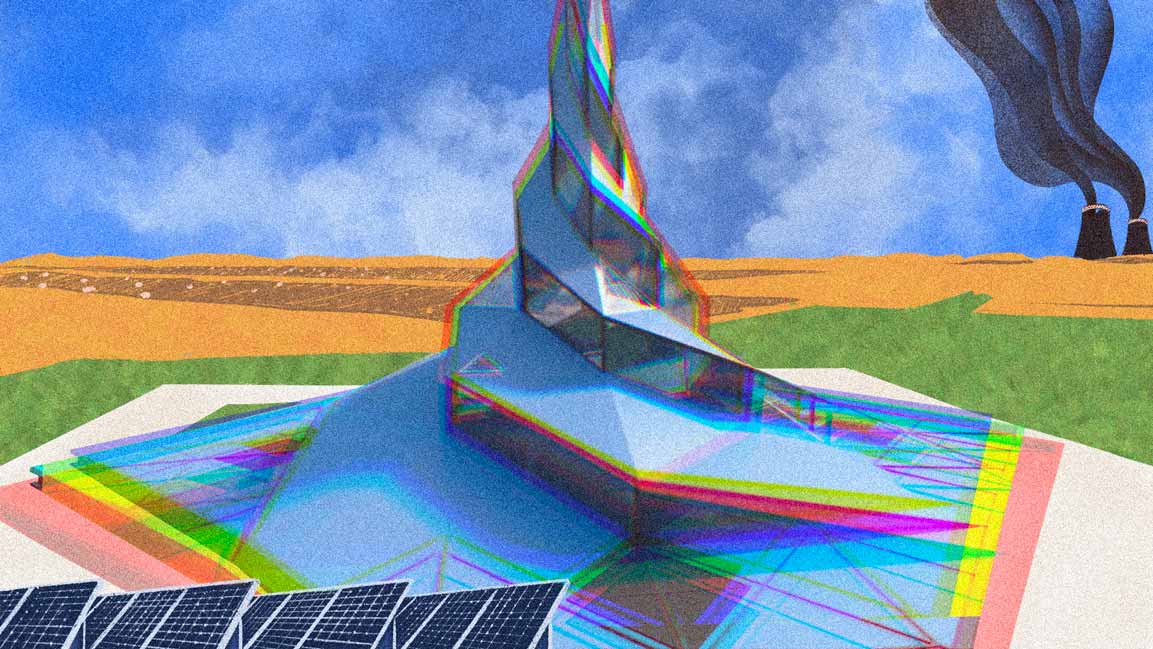- | 10:30 am
Can solar power sustain an industrial revolution in the Middle East?

Saving the planet is the first thought that comes to mind when thinking of the sun’s energy. But there’s more to it than that. In addition to being the world’s largest single-site solar park, Dubai’s MBR facility is also a hub of innovation.
For instance, it has the world’s tallest CSP tower, which concentrates sunlight on a receiver using a configuration of mirrors. This is used to generate heat that creates steam for turbines, and the tower has a storage capacity that keeps supplying energy after sunset.
The MBR solar park also hired a Swedish firm Azelio to store the desert heat in a block of recycled aluminum. The stocked up energy then powers mechanical movement through a Stirling engine, leading to electricity generation to light up Dubai.
The price of solar energy has slid down by almost 90% in the last decade, and now, coal is an expensive raw material. Innovators are also proposing ways to manufacture solar panels for half the cost by doing away with silicon chips.
Only a tenth of the silicon is used for panels created directly from the element, making sense since it’ll run out someday.
Calculating the financial benefits of renewable energy brings us to solar power, which goes beyond savings on power bills to generate profits.
Solar electricity was over 200% more expensive than coal-powered units, but renewables turned the tables. Now electricity from solar or wind energy costs 177% less than coal power. Beyond the power sector, mining, manufacturing, and transportation can save money and reduce emissions by switching to renewables.
Dubai isn’t the only Middle Eastern city with a massive solar park since Abu Dhabi, Riyadh, and Manah have set up similar facilities in the Gulf. But Dubai has become the first to manufacture environment-friendly metal via electricity from the MBR solar facility.
This turns the spotlight towards industrial production using the sun and wind, including the generation of affordable hydrogen.
Let’s break down how solar power can drive the fourth industrial revolution in the Middle East.
Forging a cycle of sustainability powered by the sun
Almost every global auto brand is vying for a space in the e-vehicle market, and Germany’s BMW is among those aiming to challenge Tesla’s dominance. But what makes their cars more eco-friendly than the rest? The fact that they’ll be assembled using green aluminum components.
This procedure for producing this metal is the same as the one used for aluminum. Only now, it’s powered by clean energy. Smelters at Emirates Global Aluminium facilities are heated using solar power from the MBR solar park in Dubai to create green metal for BMW.
Aluminum alloys being lightweight and resistant to corrosion, are also instrumental in setting up more solar plants that’ll further reduce the cost of renewable energy. Dubai’s electricity and water authority are also working on using recycled aluminum to store heat at its solar park to be used at night.
Laying the foundation for green manufacturing hubs
The Red Sea lit up by the sun off the Saudi coast has been attracting travelers for years and is at the center of the kingdom’s sustainable tourism push.
But another architectural marvel, an octagon-shaped floating city, is set to power an industrial revolution with clean power. Backed by AI, the city will have it all, including autonomous transport, sustainable agriculture, and digital manufacturing fueled by 100% renewable energy.
It’s part of the same NEOM project, which is working on a solar dome to provide energy for desalination to supply clean water across Saudi Arabia. The Middle East’s largest solar panel factory is in Saudi Arabia’s Tabuk, specifically NEOM.
Driving the change with green transportation
Solar-powered electric delivery vans have appeared at Dubai Expo 2020, promising new possibilities for eCommerce in the region. Qatar is preparing for the FIFA World Cup with bus depots with solar canopies to power electric buses.
Making the most of renewables to strike gold
Beyond producing green aluminum for eco-friendly EVs, solar power adds value to precious metals in the region. Renewable firm Juvi uses solar power to create a hybrid energy model for Egypt’s Sukari gold mine. Sungrow’s storage batteries with smart air-cooling and anti-corrosion tech will ensure supply in the harsh terrain after sunset.
This initiative will cut down diesel consumption at the mine by more than 20 million liters every year, leading to a significant drop in emissions.t It’ll make operations more profitable by reducing fuel costs and expenses on maintenance for power storage.
Coal is responsible for 40% of costs at thermal power plants. Sunlight and wind are free.
As demand for renewable energy rises, the technology to set up solar power plants becomes more affordable, further driving down energy prices. The more industries adopt solar power, the cheaper it gets, and they save on manufacturing.
As long as we keep consumption in check, it’s a win-win situation for the planet, the people, and the businesses.








































